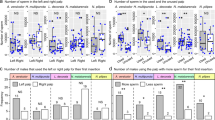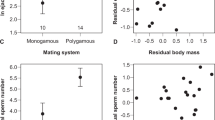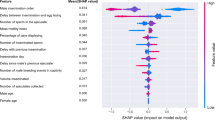Abstract
Sperm competition occurs when a female copulates with two or more males and the sperm of those males compete within the female's reproductive tract to fertilize her eggs1,2. The frequent occurrence of sperm competition has forced males of many species to develop different strategies to overcome the sperm of competing males1,3. A prevalent strategy is for males to increase their sperm investment (total number of sperm allocated by a male to a particular female) after detecting a risk of sperm competition1,3,4. It has been shown that the proportion of sperm that one male contributes to the sperm pool of a female is correlated with the proportion of offspring sired by that male5,6. Therefore, by increasing his sperm investment a male may bias a potential sperm competition in his favour5,7,8. Here we show that male meadow voles, Microtus pennsylvanicus, increase their sperm investment when they mate in the presence of another male's odours. Such an increase in sperm investment does not occur by augmenting the frequency of ejaculations, but by increasing the amount of sperm in a similar number of ejaculations.
This is a preview of subscription content, access via your institution
Access options
Subscribe to this journal
Receive 51 print issues and online access
$199.00 per year
only $3.90 per issue
Buy this article
- Purchase on Springer Link
- Instant access to full article PDF
Prices may be subject to local taxes which are calculated during checkout



Similar content being viewed by others
References
Birkhead, T. R. & Møller, A. P. (eds) Sperm Competition and Sexual Selection (Academic, San Diego, 1998)
Smith, R. L. (ed.) Sperm Competition and the Evolution of Animal Mating Systems (Academic, Orlando, 1984)
Wedell, N., Gage, M. J. G. & Parker, G. A. Sperm competition, male prudence and sperm-limited females. Trends Ecol. Evol. 17, 313–320 (2002)
Parker, G. A., Ball, M. A., Stockley, P. & Gage, M. J. G. Sperm competition games: a prospective analysis of risk assessment. Proc. R. Soc. Lond. B 264, 1793–1802 (1997)
Dewsbury, D. A. in Sperm Competition and the Evolution of Animal Mating Systems (ed. Smith, R. L.) 547–571 (Academic, New York, 1984)
Dziuk, P. J. Factors that influence the proportion of offspring sired by a male following heterospermic insemination. Anim. Reprod. Sci. 43, 65–88 (1996)
Ginsberg, J. R. & Huck, U. W. Sperm competition in mammals. Trends Ecol. Evol. 4, 74–79 (1989)
Schwagmeyer, P. L. & Foltz, D. W. Factors affecting the outcome of sperm competition in thirteen-lined ground squirrels. Anim. Behav. 39, 156–162 (1990)
Wedell, N. & Cook, P. A. Butterflies tailor their ejaculate in response to sperm competition risk and intensity. Proc. R. Soc. Lond. B 266, 1033–1039 (1999)
Gage, M. J. G. Risk of sperm competition directly affects ejaculate size in the Mediterranean fruit fly. Anim. Behav. 42, 1036–1037 (1991)
Pilastro, A., Scaggiante, M. & Rasotto, M. B. Individual adjustment of sperm expenditure accords with sperm competition theory. Proc. Natl Acad. Sci. USA 99, 9913–9915 (2002)
Pizzari, T., Cornwallis, C. K., Lovlie, H., Jakobsoon, S. & Birkhead, T. R. Sophisticated sperm allocation in male fowl. Nature 426, 70–74 (2003)
Baker, R. R. & Bellis, M. A. Human Sperm Competition 203–227 (Chapman & Hall, New York, 1995)
Bellis, M. A., Baker, R. R. & Gage, M. J. G. Variation in rat ejaculates consistent with the Kamikaze-Sperm hypothesis. J. Mamm. 71, 479–480 (1990)
Lezama, V., Orihuela, A. & Angulo, R. Sexual behavior and semen characteristics of rams exposed to their own semen or semen from a different ram on the vulva of the ewe. Appl. Anim. Behav. Sci. 75, 55–60 (2001)
Dewsbury, D. A. Ejaculate cost and male choice. Am. Nat. 119, 601–610 (1982)
Johnston, R. E. in Pheromones and Reproduction in Mammals (ed. Vandenbergh, J. G.) 3–37 (Academic, New York, 1983)
Brown, R. E. & Macdonald, D. W. (eds) Social Odours in Mammals 1–36 (Oxford Univ. Press, Oxford, 1985)
Ferkin, M. H. & Johnston, R. E. Meadow voles, Microtus pennsylvanicus, use multiple sources of scent for sex recognition. Anim. Behav. 49, 37–44 (1995)
Boonstra, R., Xia, X. & Pavone, L. Mating system of the meadow vole, Microtus pennsylvanicus. Behav. Ecol. 4, 83–89 (1993)
Dewsbury, D. A. Patterns of copulatory behavior in male mammals. Q. Rev. Biol. 47, 1–33 (1972)
Dewsbury, D. A. Diversity and adaptation in rodent copulatory behavior. Science 190, 947–954 (1975)
Gray, G. D. & Dewsbury, D. A. A quantitative description of the copulation behaviour of meadow voles (Microtus pennsylvanicus). Anim. Behav. 23, 261–267 (1975)
Pound, N. Effects of morphine on electrically evoked contractions of the vas deferens in two congeneric rodent species differing in sperm competition intensity. Proc. R. Soc. Lond. B 266, 1755–1758 (1999)
Parker, G. A. Sperm competition games: raffles and roles. Proc. R. Soc. Lond. B 242, 120–126 (1990)
Birkhead, T. R. & Møller, A. P. Sperm Competition in Birds: Evolutionary Causes and Consequences (Academic, London, 1992)
Simmons, L. W. Sperm Competition and its Evolutionary Consequences in the Insects 144–187 (Princeton Univ. Press, Princeton, 2001)
Robb, G. W., Amann, R. P. & Killian, G. J. Daily sperm production and epididymal sperm reserves of pubertal and adult rats. J. Reprod. Fertil. 54, 103–107 (1978)
Ferkin, M. H., Lee, D. N. & Leonard, S. T. The reproductive state of female voles affects their scent marking behavior and the responses of male conspecifics to such marks. Ethology 110, 257–272 (2004)
Dewsbury, D. A. & Baumgardner, D. J. Studies of sperm competition in two species of muroid rodents. Behav. Ecol. Sociobiol. 9, 121–133 (1981)
Acknowledgements
This work was supported by a Sigma Xi Grant-in-Aid of Research to J.d.-T., a NIH Grant to M.H.F. and a NIH Grant to the Tennessee Mouse Genome Consortium. J.d.-T. designed and carried out the experiments, analysed the data and wrote the paper; M.H.F. assisted in writing of the final drafts of the paper, as well as providing research facilities, animals and material.
Author information
Authors and Affiliations
Corresponding author
Ethics declarations
Competing interests
The authors declare that they have no competing financial interests.
Rights and permissions
About this article
Cite this article
delBarco-Trillo, J., Ferkin, M. Male mammals respond to a risk of sperm competition conveyed by odours of conspecific males. Nature 431, 446–449 (2004). https://doi.org/10.1038/nature02845
Received:
Accepted:
Issue Date:
DOI: https://doi.org/10.1038/nature02845
This article is cited by
-
Reproductive biology of male common dolphins (Delphinus delphis) in New Zealand waters
Marine Biology (2023)
-
Female copulation song is modulated by seminal fluid
Nature Communications (2020)
-
Characterizing the scent and chemical composition of Panthera leo marking fluid using solid-phase microextraction and multidimensional gas chromatography–mass spectrometry-olfactometry
Scientific Reports (2017)
-
Sperm competition risk drives plasticity in seminal fluid composition
BMC Biology (2015)
-
Genetic and phenotypic influences on copulatory plug survival in mice
Heredity (2015)
Comments
By submitting a comment you agree to abide by our Terms and Community Guidelines. If you find something abusive or that does not comply with our terms or guidelines please flag it as inappropriate.



